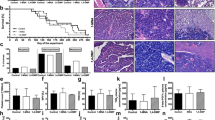Summary
Investigations on mechanisms of metastatic tumour spread revealed a role for compounds that inhibit tumour dissemination at the time of hematogenous dissemination. The platelet aggregation inhibitor prostacyclin and its stable analogues were shown to inhibit tumour-cell-induced platelet interaction as well as tumour cell adhesive mechanisms. This study concentrates on the effect of the stable prostacyclin analogue cicaprost: 5-{(E)-(1S, 5S, 6S, 7R)-7-hydroxy-6-[(3S, 4S)-3-hydroxy-4-methylnona-1,6-diinyl]-bicyclo[3,3,0]octan-3-ylidene}-3-oxapentanoic acid (Schering AG), as cyclodextrin clathrate, on spontaneous tumour metastases of two different carcinomas of the rat. In Cop rats bearing spontaneously metastasizing R 3327 MAT Lu prostate carcinomas, cicaprost (1.0 mg/kg p.o. daily) inhibited the number of lung metastases by about 80%, whereas the lower doses (0.1 and 0.5 mg/kg) exhibited borderline efficacy. In female Wistar-Furth rats bearing s.c. implanted SMT 2A mammary carcinomas, spontaneously metastasizing into regional lymph nodes and lungs, cicaprost (0.1, 0.5 and 1 mg/kg) p.o. daily exhibited a dose-dependent inhibition of the number of lung metastases. Five out of ten animals treated by 1 mg/kg were free of visible lung metastases. The weight of the axillary lymph node was significantly reduced by the 1 mg/kg dose of cicaprost, whereas lower doses has no effect on the weight of the lymph nodes. The growth of the primary tumour was not influenced by cicaprost in the R 3327 MAT Lu prostate carcinoma nor in the SMT 2A mammary carcinoma in the dose range tested. In conclusion, the stable prostacyclin analogue cicaprost exhibits a strong antimetastatic action in two metastasizing tumours of the rat and interferes with the steps not only of haematogenous, but also of lymphogenous metastasis.
Similar content being viewed by others
References
Bani MR, Garafolo A, Scanziani E, Giavazzi R (1991) Effect of interleukin-1-beta on metastasis formation in different tumor systems. JNCI 83:119–123
Brodt P (1990) Adhesion mechanisms in lymphatic metastasis. Cancer Metastasis Rev 10:23–32
Costantini V, Fuschiotti M, Allegrucci G, Agnelli G, Nenci GG, Fioretti MC (1988) Platelet-tumor cell interaction: effect of prostacyclin and a synthetic analogue on metastasis formation. Cancer Chemother Pharmacol 22:289–297
Dejana E, Bertochi F, Bortolami MC, Regonesi A, Tonta A, Breviarion F, Giavazzi R (1988) Interleukin 1 promotes tumor cell adhesion to cultured endothelial cells. J Clin Invest 82:1466–1470
Gasic GJ (1984) Role of plasma, platelets, and endothelial cells in tumor metastasis. Cancer Metastasis Rev 3:99–116
Grundmann HJ, Hähnle U, Hegenscheid B, Stahlmüller G, Bienzle U, Blitstein-Willinger E (1992) Inhibition of endotoxin-induced macrophage TNF-expression by a prostacyclin analogue and its beneficial effect in experimental LPS intoxication. J Infect Disease 165:501–505
Honn KV (1991) Eicosanoid regulation of cancer cell-platelet interaction and endothelial cell retraction during arrest and extravasation. Eicosanoids 4 [Suppl]:13
Honn KV, Busse WD, Sloane BF (1983) Prostacyclin and thromboxane. Implication for their role in tumor cell metastasis. Biochem Pharmacol 32:1–11
Honn KV, Grossi IM, Diglio CA, Wojtukiewicz M, Taylor ID (1989) Enhanced tumor cell ahdesion to subendothelial matrix resulting from 12(S)-HETE-induced endothelial cell retraction. FASEB J 3:2285–2293
Honn KV, Grossi IM, Diglio CA, Taylor JD (1990) Role of 12-lipoxygenase metabolites and integrine glycoprotein receptors in metastasis. In: Etievant C, Cros J, Rustum YM (eds) Pierre Fabre Monograph Series, vol 3. New concepts in cancer. Macmillan, Houndmills, pp 42–62
Kim U (1970) Metastasizing carcinomas in rats: induction and study of their immunogenicity. Science 167:72–74
Kim U (1986) Pathogenesis and characteristics of spontaneously metastasizing mammary carcinomas and the general principles of metastases. J Surg Oncol 33:151–165
Kim U, Park HC, Choi KH (1988) Differential permeability of lymphatic and blood vessels in determining the route of metastasis as demonstrated by indirect lymphography. Clin Expl Metastasis 6:291–299
Lazan DW, Heston WDW, Kadman D, Fair WR (1982) Inhibition of the R 3327 MAT Lu prostatic tumor by diethylstilbestrol and 1,2-Bis (3,5-dioxopiperazin-1-yl)propane. Cancer Res 42:1390–1394
Levine AS (1989) The biology of human cancer, and the development of a rational basis for treatment. In: Kaiser HE (ed) Cancer growth and progression vol. 1. Kluwer Academic Publisher, Dortrecht, pp 1–22
Liotta LA, Stetler-Stevenson WG (1991) Tumor invasion and metastasis: an imbalance of positive and negative regulation. Cancer Res 51 [Suppl]:5054–5059
Müller B, Schmidtke M, Witt W (1988) Adherence of leucocytes to electrically damaged venules in vivo. Eicosanoids 1:13–17
Nakajima M, Fabra A, Gilmore LB, Welch DR (1990) TGF-beta stimulates production of basement membrane degrading enzymes, invasion and lung colonisation of rat mammary adenocarcinoma cells. Clin Expl Metastasis 8 [Suppl]:23–24
Nicolson GL (1988) Differential organ tissue adhesion, invasion, and growth properties of metastatic rat mammary adenocarcinoma cells. Breast Cancer Res Treat 12:167–176
Schirner M, Schneider MR (1991a) The stable prostacyclin analogue cicaprost inhibits tumor metastases in M 5076 reticulum sarcoma. Eicosanoids4 [Suppl]:23
Schirner M, Schneider MR (1991b) Cicaprost inhibits metastases of animal tumors. Prostaglandins 42:451–461
Schneider MR, Schillinger E, Schirner M, Skuballa W, Stürzebecher CS, Witt W (1990) Effects of prostacyclin analogues in in vivo tumor models. In: Samuelsson B, Paoletti R, Ramwell PW (eds) Advances in prostaglandin, thromboxane, and leukotriene research, vol 21 b. Raven, New York, pp 901–908
Skuballa W, Schillinger E, Stürzebecher CS, Vorbrüggen H (1986) Synthesis of a new chemically and metabolically stable prostacyclin analogue. J Med Chem 29:313–319
Author information
Authors and Affiliations
Rights and permissions
About this article
Cite this article
Schirner, M., Schneider, M.R. The prostacyclin analogue cicaprost inhibits metastasis of tumours of R 3327 MAT Lu prostate carcinoma and SMT 2A mammary carcinoma. J Cancer Res Clin Oncol 118, 497–501 (1992). https://doi.org/10.1007/BF01225263
Received:
Accepted:
Issue Date:
DOI: https://doi.org/10.1007/BF01225263




